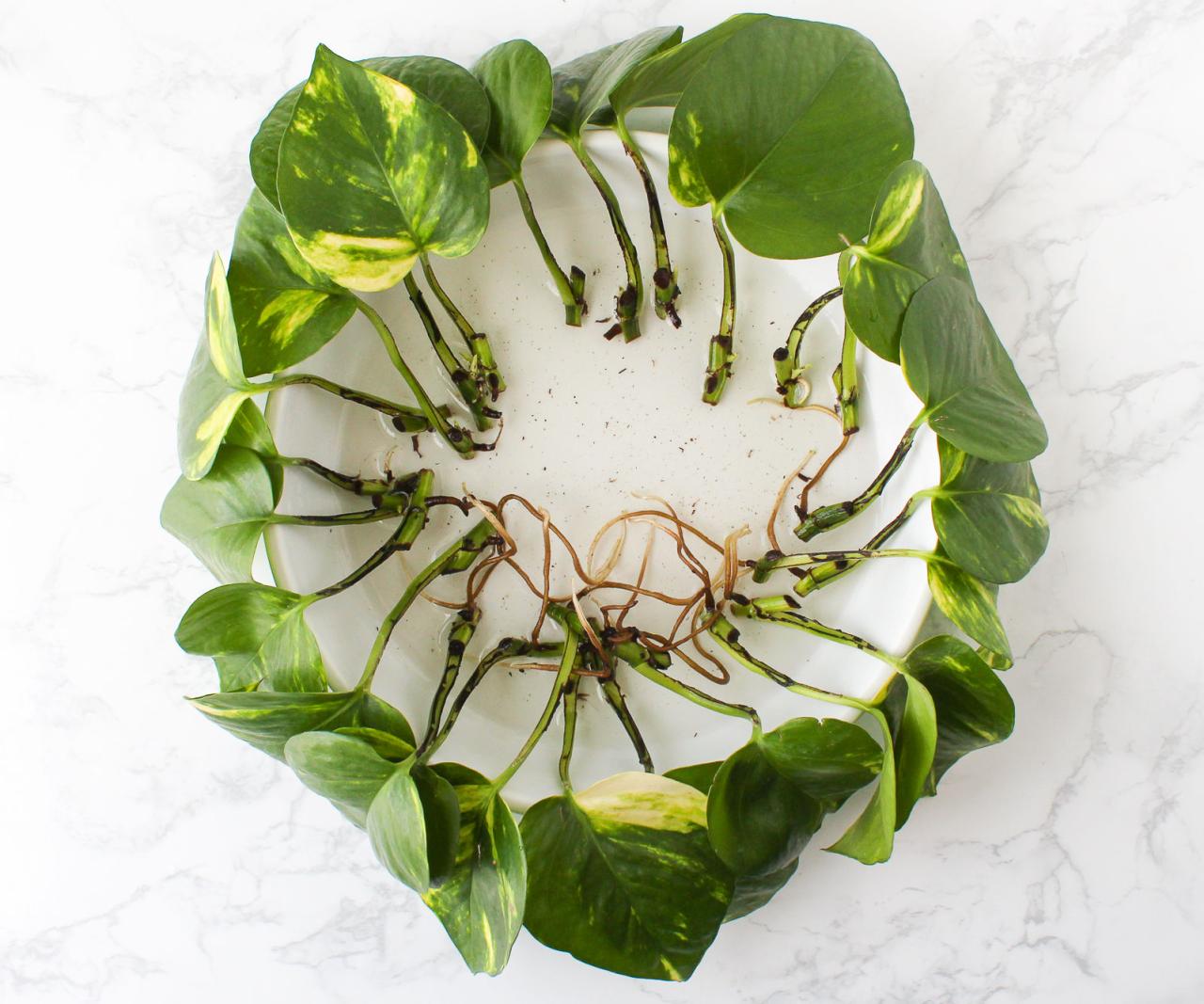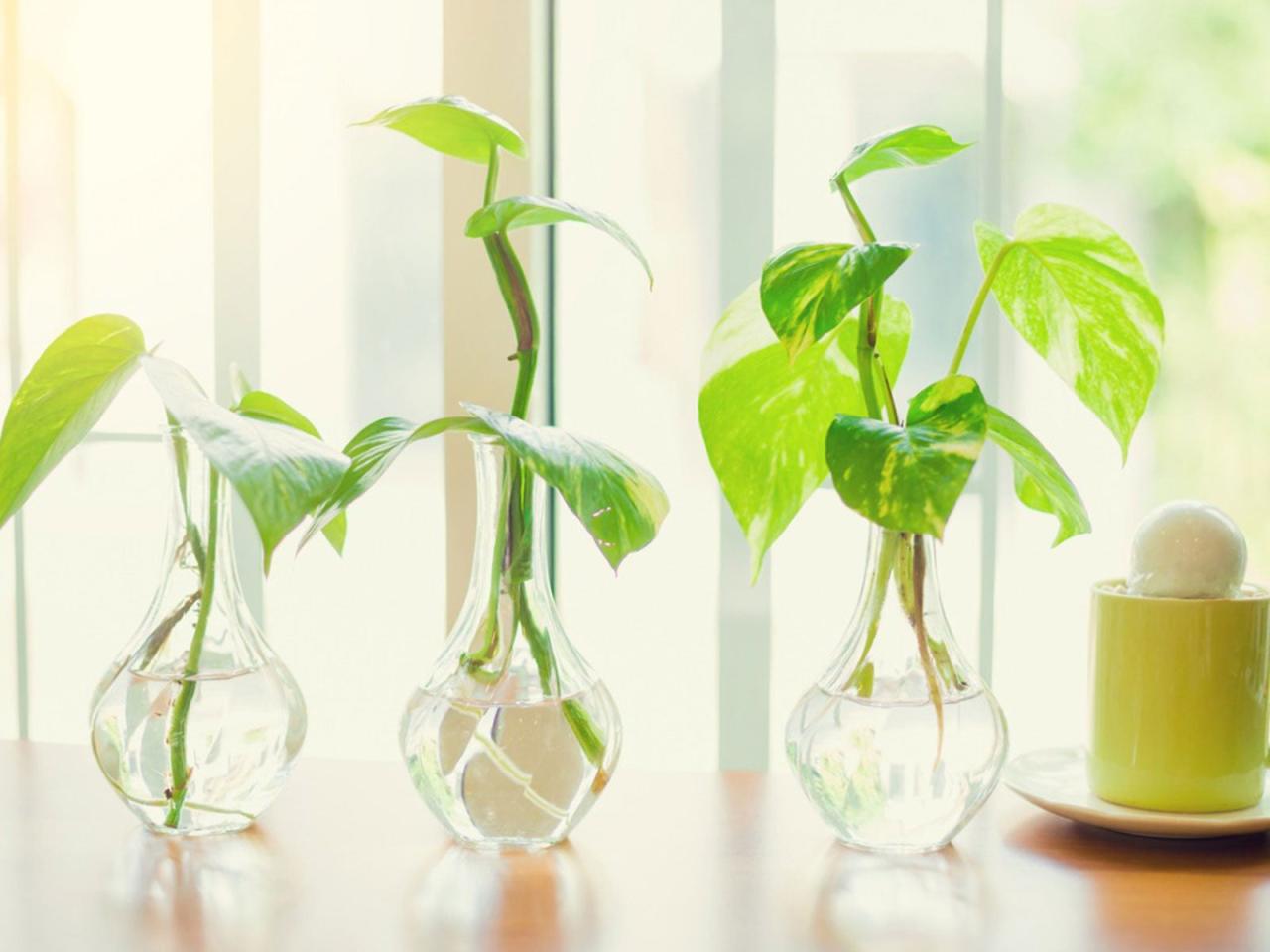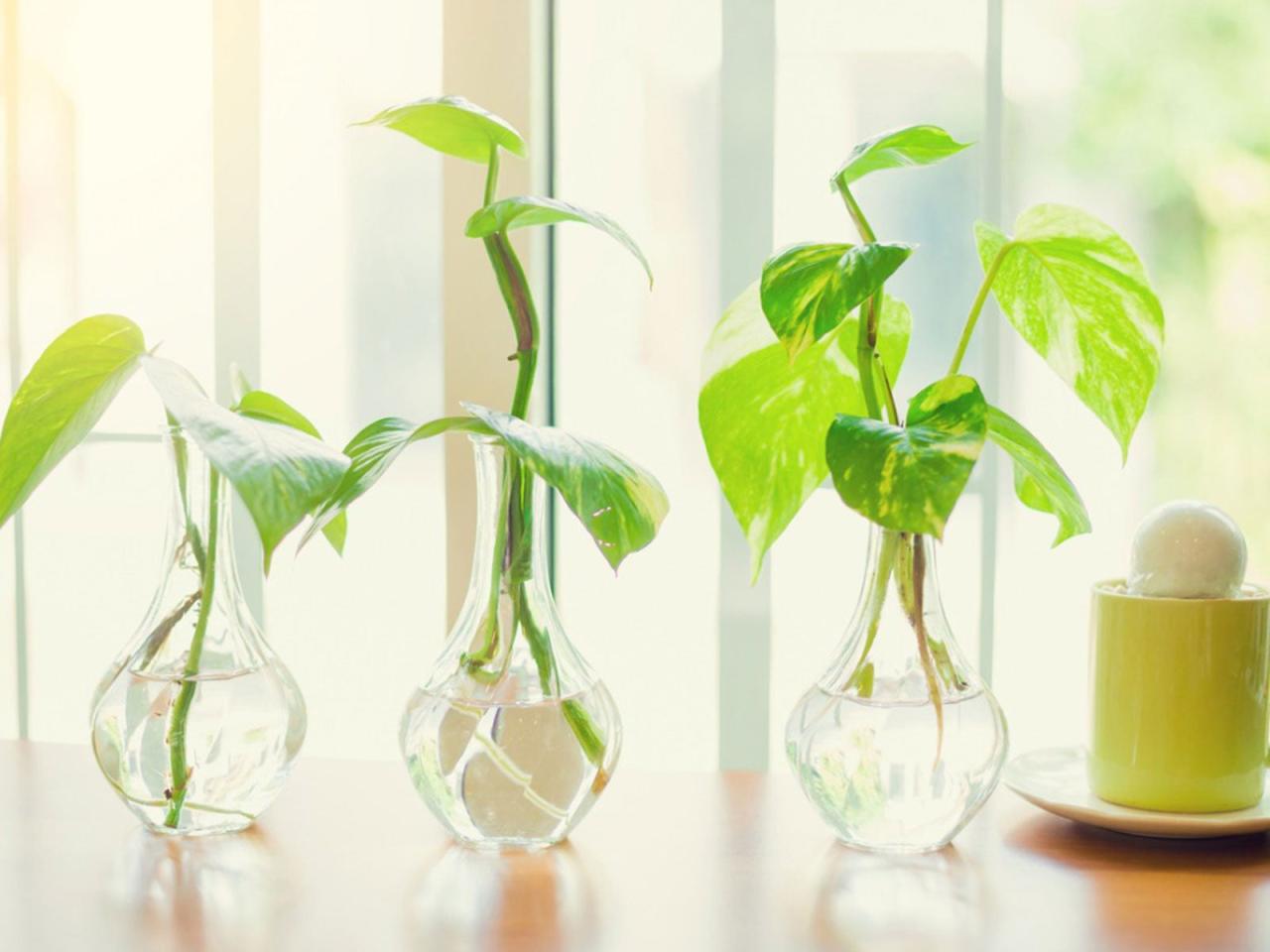The Best Methods for Propagating Pothos in Soil for Lush Growth! Pothos, with its cascading foliage and adaptability, is a beloved houseplant that can easily be propagated to create new plants and enhance your indoor greenery. Whether you’re a seasoned gardener or just starting out, propagating pothos is a rewarding and straightforward process.
This comprehensive guide will explore the best methods for propagating pothos in soil, ensuring healthy growth and lush foliage for your home.
From selecting the right soil to understanding the intricacies of cutting preparation and post-planting care, we’ll delve into each step, providing practical tips and solutions for success. This guide will cover the most effective propagation techniques, including stem cuttings and water propagation, as well as troubleshooting common issues and enhancing growth for a vibrant pothos collection.
Introduction to Pothos Propagation
Pothos propagation is a simple and rewarding process that allows you to create new plants from cuttings of your existing pothos. This is a great way to expand your collection of pothos plants or share them with friends and family.
Pothos plants are known for their adaptability and ease of care, making them a popular choice for beginner gardeners. They are also relatively low-maintenance, requiring minimal attention to thrive.
The Benefits of Propagating Pothos
Propagating pothos offers numerous benefits for home gardeners. Here are some key advantages:
- Cost-Effective:Propagating pothos allows you to create new plants without spending money on purchasing new ones from nurseries or garden centers.
- Increased Plant Collection:Propagating pothos allows you to quickly expand your collection of these versatile plants, filling your home with lush greenery.
- Sharing with Others:Propagated pothos cuttings make excellent gifts for friends and family who appreciate the beauty and ease of care these plants offer.
Pothos Plants: Characteristics and Popularity
Pothos, scientifically known as Epipremnum aureum, are evergreen perennial vines that are native to the Solomon Islands. They are characterized by their heart-shaped leaves, which can vary in color depending on the cultivar. Some common pothos varieties include:
- Golden Pothos:Features bright yellow variegation on its leaves.
- Marble Queen Pothos:Known for its striking white variegation that resembles marble.
- Neon Pothos:Exhibits vibrant lime-green leaves that add a pop of color to any space.
Pothos plants are popular among home gardeners for several reasons:
- Low Maintenance:Pothos can tolerate a wide range of conditions, making them relatively easy to care for.
- Air-Purifying Properties:Pothos plants are known to remove toxins from the air, improving indoor air quality.
- Versatility:Pothos can be grown in hanging baskets, on shelves, or even as groundcover.
Soil Selection and Preparation
The right soil mixture is crucial for pothos propagation, ensuring the cuttings root successfully and thrive. A well-draining, airy soil is essential for healthy root development, while the right nutrients provide the necessary support for growth.
Soil Composition
The ideal soil for pothos propagation should be a well-draining, airy mixture that retains moisture but prevents waterlogging. A combination of:* Potting Mix:This provides a base for the soil, containing essential nutrients and organic matter.
While propagating pothos in soil is a popular method for creating new plants, it’s not the only way to enjoy lush greenery. For those seeking a more challenging but rewarding endeavor, consider growing persimmon trees from seed – a process that can be surprisingly simple.
Learn how to cultivate these unique trees from seed with these easy steps: Grow Lush Persimmon Trees from Seed with These Simple Steps!. Returning to pothos, once you’ve mastered the basics of propagation, experiment with different soil mixtures and lighting conditions to find the perfect environment for your plants to thrive.
Perlite
This lightweight material improves drainage and aeration, preventing the soil from becoming compacted.
Vermiculite
This helps retain moisture and provides nutrients, creating a favorable environment for root growth.
Preparing the Soil Mixture
- Combine the ingredients:In a large container, mix equal parts of potting mix, perlite, and vermiculite. This ratio can be adjusted based on the specific needs of the pothos variety.
- Moisten the mixture:Gently add water to the soil mix, ensuring it is evenly moist but not soggy. The soil should feel slightly damp to the touch.
- Sterilize the soil (optional):To prevent fungal diseases, you can sterilize the soil by microwaving it for 1-2 minutes. This kills any harmful microorganisms present.
Drainage and Aeration
- Importance of drainage:Good drainage is essential for pothos propagation, as waterlogged soil can lead to root rot and hinder root development. The soil mixture should allow excess water to drain freely, preventing the roots from sitting in water.
- Importance of aeration:Aeration refers to the presence of air pockets within the soil, which is crucial for root respiration and growth. A well-aerated soil allows oxygen to reach the roots, promoting healthy growth.
Propagation Methods

Pothos propagation offers numerous advantages, including creating new plants from cuttings, expanding your collection, and gifting them to friends. This section delves into the most common methods for propagating pothos, providing a comprehensive guide to successful plant multiplication.
Stem Cuttings
Stem cuttings are a popular and effective method for propagating pothos. This technique involves taking a section of a healthy stem and encouraging it to develop roots. Here’s a step-by-step guide:
- Select a Healthy Stem:Choose a healthy pothos stem with at least two nodes (the points where leaves grow). Ensure the stem is free from any signs of disease or pests.
- Cut the Stem:Use a sharp, clean knife or pruning shears to make a clean cut just below a node. This encourages root development at the cut.
- Prepare the Cutting:Remove any leaves that would be submerged in the soil or water. This prevents rot and promotes root growth.
- Insert the Cutting:Plant the cutting into a pot filled with well-draining potting mix, ensuring the node is buried in the soil. Water the cutting thoroughly and place it in a warm, bright location, but out of direct sunlight.
- Maintain Humidity:Maintain high humidity around the cutting to encourage root development. You can cover the pot with a plastic bag or dome to create a humid environment.
- Monitor and Care:Check the soil moisture regularly and water when it starts to dry out. The cutting should start to develop roots within a few weeks.
Water Propagation
Water propagation is another simple and effective method for propagating pothos. This method involves placing a stem cutting in a container of water and allowing it to develop roots. Here’s a detailed guide:
- Prepare the Cutting:Follow the same steps as described in the stem cuttings method to select a healthy stem, cut it below a node, and remove any leaves that would be submerged in the water.
- Place the Cutting in Water:Fill a clean glass or jar with water and place the cut end of the stem into the water. Ensure the water level is just below the node.
- Change the Water Regularly:Change the water every 2-3 days to prevent the growth of bacteria and algae.
- Monitor Root Development:Observe the cutting regularly for root development. Roots will typically appear within a few weeks.
- Transplant to Soil:Once the roots are at least an inch long, transplant the cutting into a pot filled with well-draining potting mix. Ensure the roots are gently spread out in the soil. Water the cutting thoroughly and place it in a warm, bright location, but out of direct sunlight.
Comparison of Propagation Methods
Both stem cuttings and water propagation methods are effective for propagating pothos. However, there are some key differences:
- Stem Cuttings:Stem cuttings are generally considered a more reliable method for propagating pothos, as they provide a direct connection between the cutting and the soil, promoting root development.
- Water Propagation:Water propagation is a simpler and more convenient method, but it can be less reliable than stem cuttings. The roots may be more fragile and prone to damage during transplantation.
Cutting Preparation and Planting
Once you have your healthy pothos cuttings, you’ll need to prepare them for planting. This involves making sure the cuttings are ready to root and creating a favorable environment for growth.
Preparing Pothos Cuttings for Planting
After selecting your cuttings, prepare them for planting by removing the lower leaves. These leaves will be submerged in the soil and are prone to rotting, potentially hindering root development. To remove the leaves, gently pinch or cut them off using clean scissors or pruning shears.
Similar to the success achieved when propagating pothos, mastering the art of propagating star jasmine can yield an abundance of fragrant blooms. For a comprehensive guide on cultivating this fragrant vine, explore How to Propagate Star Jasmine: Create a Lush and Fragrant Garden!.
Once you’ve mastered the techniques, you’ll be well-equipped to apply similar principles to propagating pothos in soil for lush growth.
You can leave the top two or three leaves on the cutting for photosynthesis.
- Use a sharp knife or pruning shears to make a clean, angled cut just below a node. This encourages root growth.
- To further stimulate root growth, you can dip the cut end of the pothos cutting in rooting hormone powder. This is optional but can help promote faster and more vigorous root development.
Planting Pothos Cuttings
After preparing your cuttings, it’s time to plant them. You can use small pots, seed trays, or even clear plastic cups.
- Fill your chosen container with the prepared potting mix. Make a small hole in the center of the soil with your finger or a pencil.
- Place the prepared cutting in the hole, ensuring that the node is buried just below the soil surface.
- Gently press the soil around the cutting to secure it in place.
- Water the cutting thoroughly, ensuring the soil is evenly moistened.
Post-Planting Care and Maintenance
Once your pothos cuttings have rooted and established themselves in their new pots, providing them with the right care is essential for healthy growth and lush foliage. This involves understanding the specific needs of pothos plants, particularly when they are still young and developing their root systems.
Watering Newly Propagated Pothos
Proper watering is crucial for the success of your propagated pothos. Newly rooted cuttings are especially vulnerable to overwatering, which can lead to root rot and plant death.
- Water thoroughly, but only when the soil is mostly dry.This means checking the soil moisture with your finger or a moisture meter.
- Avoid letting the soil become completely soaked.Allow excess water to drain out of the pot’s drainage holes.
- Adjust watering frequency based on the environment.During hotter, drier months, your pothos may require more frequent watering.
Fertilizing Young Pothos Plants, The Best Methods for Propagating Pothos in Soil for Lush Growth!
While pothos are relatively low-maintenance plants, they do benefit from occasional fertilization, especially during their initial growth stages.
- Start fertilizing about a month after planting.This allows the roots to establish themselves before introducing additional nutrients.
- Use a balanced liquid fertilizer diluted to half strength.Avoid over-fertilizing, as this can damage the roots.
- Fertilize every 2-4 weeks during the growing season.Reduce fertilization during the winter months when growth slows down.
Providing Adequate Light
Pothos thrive in bright, indirect light. They can tolerate low light conditions, but they will grow more vigorously and produce lusher foliage with adequate light exposure.
- Place your pothos in a location that receives bright, indirect light.Avoid direct sunlight, which can scorch the leaves.
- Rotate your pothos plant regularly.This ensures that all sides of the plant receive equal light and prevents it from becoming leggy.
- Consider using a grow light if natural light is limited.Grow lights can provide supplemental light during the winter months or in low-light locations.
Maintaining Humidity
Pothos prefer moderately humid environments. While they can tolerate dry air, increased humidity can promote healthier growth and prevent leaf browning.
- Group your pothos plants together.This creates a microclimate that increases humidity around the plants.
- Use a humidifier.A humidifier can add moisture to the air, especially during dry seasons.
- Mist your pothos plants regularly.This helps to increase humidity levels and keeps the leaves hydrated.
Common Issues During Pothos Propagation and Solutions
While pothos propagation is generally straightforward, some common issues may arise.
- Root rot:Overwatering is the most common cause of root rot. If your pothos leaves are yellowing and drooping, and the soil is constantly wet, it could be a sign of root rot. Repot the plant in fresh, well-draining soil and reduce watering frequency.
- Leaf drop:Sudden changes in temperature, humidity, or light can cause leaf drop. Ensure your pothos is in a consistent environment and avoid drastic changes.
- Pests:Pothos are relatively pest-resistant, but they can occasionally be affected by mealybugs, aphids, or spider mites. Treat any infestations with insecticidal soap or neem oil.
Troubleshooting and Common Problems
While pothos propagation is generally straightforward, several issues can arise, leading to stunted growth or even failure. Understanding the causes of these problems and implementing appropriate solutions can significantly improve your success rate.
Identifying and Addressing Common Issues
Understanding the potential issues during pothos propagation allows for timely intervention and prevents complications. The following table provides a comprehensive overview of common problems, their causes, and recommended solutions.
Issue |
Cause |
Solution |
|---|---|---|
No Root Growth |
Insufficient humidity, inadequate light, or improper cutting preparation |
Maintain high humidity levels using a humidity dome or misting. Provide bright, indirect light. Ensure cuttings are taken from healthy stems with at least two nodes. |
Root Rot |
Overwatering, poor drainage, or overly compacted soil |
Allow the soil to dry slightly between waterings. Use a well-draining potting mix. Avoid over-packing the soil. |
Yellowing Leaves |
Overwatering, nutrient deficiency, or root damage |
Reduce watering frequency. Provide a balanced fertilizer specifically designed for houseplants. Repot the plant if roots are circling the pot. |
Wilting |
Underwatering, extreme temperatures, or pests |
Water thoroughly when the top inch of soil is dry. Protect the plant from direct sunlight and extreme temperature fluctuations. Inspect for pests and treat accordingly. |
Leaf Drop |
Sudden changes in environment, stress, or disease |
Acclimate new cuttings gradually to their new environment. Avoid drastic changes in temperature or light conditions. Treat any fungal diseases promptly. |
Enhancing Growth and Lushness

After successfully propagating your pothos, the next step is to nurture it into a lush, thriving plant. While pothos are known for their resilience, providing optimal conditions can encourage vigorous growth and a more vibrant appearance.
Optimizing Light and Watering
Light and water are crucial factors for pothos growth. Pothos thrive in bright, indirect light. Direct sunlight can scorch the leaves, so it’s best to avoid exposing them to harsh midday sun. Regular watering is essential, allowing the soil to dry slightly between waterings.
Overwatering can lead to root rot, so ensure proper drainage.
The Importance of Pruning and Pinching
Pruning and pinching are essential for maintaining the health and shape of your pothos. Regular pruning helps to remove any dead or diseased leaves, encouraging new growth. Pinching the tips of the stems encourages bushier growth, creating a fuller, more attractive plant.
Providing the Right Environment
Pothos prefer warm temperatures and humidity. Keeping your pothos in a well-ventilated area with temperatures between 65-85°F (18-29°C) is ideal. You can also increase humidity by placing a humidifier nearby or grouping plants together.
Final Review: The Best Methods For Propagating Pothos In Soil For Lush Growth!

Propagating pothos in soil offers a rewarding experience for plant enthusiasts of all levels. By following the guidelines Artikeld in this guide, you can successfully propagate pothos and enjoy the lush greenery of these versatile plants. From selecting the right soil and preparing cuttings to providing proper post-planting care, each step contributes to the healthy growth and beauty of your pothos collection.
Remember, patience and attention to detail are key to achieving lush and vibrant pothos plants that will thrive in your home for years to come.
FAQ Overview
Can I propagate pothos in water instead of soil?
Yes, you can propagate pothos in water. However, soil propagation generally results in stronger roots and faster growth.
How often should I water my newly propagated pothos?
Water your pothos when the top inch of soil feels dry to the touch. Avoid overwatering, as it can lead to root rot.
What is the best time of year to propagate pothos?
Pothos can be propagated year-round, but spring and summer are ideal as the plant is actively growing.
Can I use any type of soil for propagating pothos?
While you can use a general potting mix, a well-draining soil with a good balance of nutrients is best for pothos propagation.

